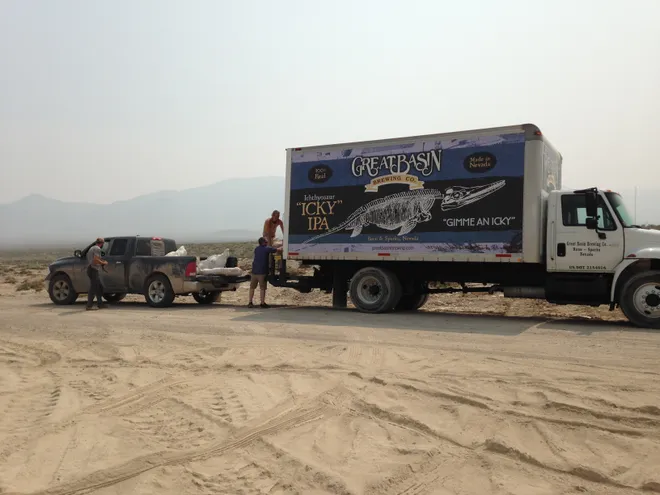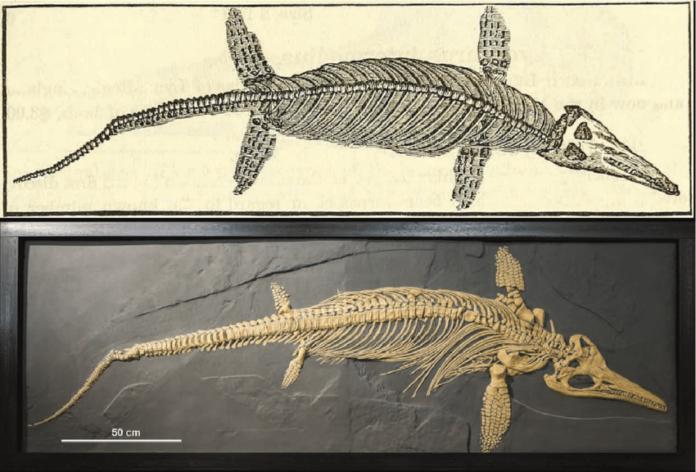Once upon a time, a giant creature dominated the Earth’s oceans during the Triassic period, nearly 200 million years ago. This creature, the ichthyosaur, was the first to reach such massive proportions on the planet. In 1993, Great Basin Brewing Company in Sparks introduced the Ichthyosaur IPA to honor this extinct creature.

Late last year, one of the earliest species of ichthyosaur was named Cymbospondylus youngorum, in honor of Tom and Bonda Young of Great Basin Brewing Company. This name was announced at a ceremony at the Natural History Museum in Los Angeles in December. The fossil of this species was found in Nevada, about 120 miles east of Reno, and is currently on display at the Natural History Museum.
Tom and Bonda Young founded Great Basin Brewing Company in Sparks in 1993. Before making beer, Tom was a geologist. His interest in fossils led him to name one of his first beers after the ichthyosaur. This ancient leviathan has regional ties, as Nevada was once underwater when the continents were still joined. Ichthyosaur fossils were found in Nevada as early as 1928 in what is now Berlin-Ichthyosaur State Park near Gabbs, home to the largest known concentration of ichthyosaur fossils in the world. One species, Shonisaurus popularis, was named the state fossil in 1977.

A German research team searching for fossils in Nevada learned about the beer and contacted Great Basin Brewing and the Youngs. In 2011, this team found another ichthyosaur fossil in Nevada, and the Youngs helped with the excavation and removal process through monetary donations, food, and beer, and even transported the 55-foot fossil’s skull to Los Angeles in a Great Basin beer truck.
In December, the museum honored the Youngs by naming the fossil after them — the “Young” part of the scientific name.

Dr. Martin Sander, a paleontologist at the University of Bonn and research associate with the Dinosaur Institute at the Natural History Museum of Los Angeles County, led the excavation of the fossil. He discovered vertebrae of the ichthyosaur in the Augusta Mountains outside Winnemucca in October 2011.
The specimen was excavated from a rock unit called the “Fossil Hill Member” in the Augusta Mountains of Nevada, 41 miles northwest of Austin. The team then found the skull, forelimbs, and chest region of the creature.

The well-preserved skull, along with parts of the backbone, shoulder, and forefin, date back to the Middle Triassic (247.2-237 million years ago), marking the earliest case of an ichthyosaur reaching giant proportions. It measured up to 55.78 feet, making it the largest animal yet discovered from that period, on land or sea.
Excavating the fossil was an expensive endeavor. The team lived in the desert for several weeks and had to hire a helicopter to move the fossil.
Evidence suggests that this large, prehistoric, swimming reptile was pregnant when it died. The ichthyosaur was the second-oldest pregnant specimen ever found and belonged to a previously unidentified species.
An NHM spokesperson said the elongated snout and conical teeth suggest that Cymbospondylus youngorum preyed on squid and fish, but its size meant it could have hunted smaller and juvenile marine reptiles as well.

Tom Young is ecstatic about the discovery and display of the ichthyosaur. “It just makes my heart sing when I see people; this is one of the top scientists in the world, and he’s bringing it down to my level, and I get it,” Young said. “Nevada is such a unique place. This is the first giant. This is pretty cool.”
Young joked that he had a different idea for the name. “I was voting for ‘Beerosaurus’ personally,” he said, smiling. The Youngs no longer own Great Basin Brewing — it merged last year with Mark Estee’s Local Food Group — but they continue to work there as consultants. Tom is still the brewmaster.
The Youngs also support the scientific effort by spreading the word through beer, hosting a series of talks at the brewery. These fundraisers attracted hundreds of people who could hear directly from the scientists.
Tom Young said there is still much more to find and study in the central Nevada mountains.




